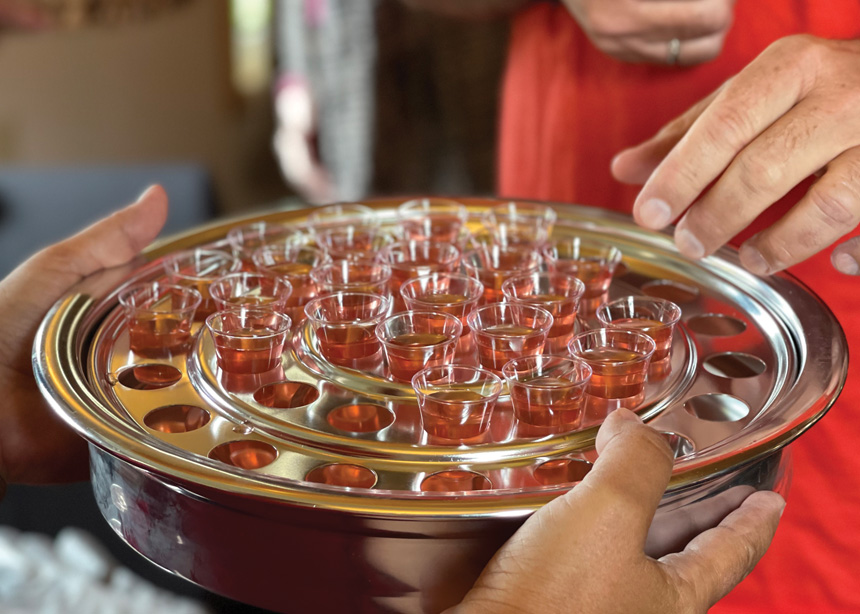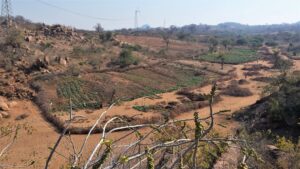On July 6, more than 160 people from a variety of denominations and organizations gathered in Ohsweken, Ontario, for a Strawberry Thanksgiving and Communion hosted by Six Nations Polytechnic and co-organized by Mennonite Central Committee Ontario (MCCO) and Adrian Jacobs, also known as Ganosono, of the Turtle Clan, Cayuga Nation of the Six Nations Haudenosaunee Confederacy of the Grand River Territory, Ontario.
Following a ceremony of welcome, the event explored Indigenous land claims on the Haldimand Tract and the church’s possible response. It ended with the sharing of communion and a lunch with strawberries.
The Haldimand Tract includes the land six miles (9.7 kilometres) to either side of the Grand River, from Dundalk, Ontario, to Lake Erie, including the Kitchener-Waterloo area. The 1874 Haldimand Treaty set aside this land for Six Nations people “to enjoy for ever.” Six Nations was to receive lease payments from those who came to reside on the land.
Today Six Nations land comprises less than five percent of the land allotted in the Haldimand Treaty.
Public attention was drawn to longstanding Six Nations land issues in 2006, when a planned subdivision on the Haldimand Tract in Caledonia, Ontario, sparked major protests.
Jacobs was among the protestors on the 2006 Victoria Day weekend when tensions between protestors, settlers and police escalated. Jacobs, who heads the Indigenous Justice and Reconciliation program of the Christian Reformed Church in North America, referred to that day during his opening address at the July 6 event: “When a backhoe raised a piece of Plank Road/Argyle Street pavement, I thought, ‘We are finally saying no to the ongoing abuse and theft we have been suffering.’”
During that time, Jacobs, then working for MCC Ontario’s Aboriginal Neighbours South Program, developed a plan to educate churches about Six Nations lands. In March 2007, Jacobs met with the Haudenosaunee Council at Onondaga Longhouse to explain these education plans. Artist and Haudenosaunee knowledge keeper Rick Hill suggested a framework for a spiritual covenant between the churches and Six Nations, one that would see churches acknowledge Six Nations’ jurisdiction over their lands, make a token lease payment, and include provision that if a church were ever de-commissioned, the land would revert to Six Nations.
Speaking at the July 6 event, Scott Morton Ninomiya of MCC Ontario’s Indigenous Neighbours program noted that the spiritual covenant proposed by Jacobs and Hill in 2007 expresses the same spirit as the Two-Row Wampum Treaty.
In a subsequent phone interview, Morton Ninomiya noted that the first two Strawberry Thanksgiving gatherings took place in 2008 and 2009, with the third this year. He described this year’s event as a joyful one in which worship and action went hand in hand.
One of the first churches to respond to the covenant was Stirling Avenue Mennonite Church in Kitchener, Ontario. Josie Winterfeld, now retired after 16 years as missions, peace and justice outreach worker at Stirling Mennonite, was among those who were immediately excited about the covenant. In an interview, Winterfeld spoke about the long, slow process Stirling has undertaken to educate themselves on Indigenous history, land history, covenant theology, treaties and the specific Six Nations spiritual covenant.
While Stirling is not yet ready to sign the full covenant, they decided to move forward with a lease commitment. In March 2024, the church committed to paying one percent of their annual operating budget, as suggested in the covenant. “[What Stirling has done represents] a tangible step that other churches can consider,” said Winterfeld. “It’s important to realize that we don’t have to have everything figured out. We can go ahead and take one small step, not knowing exactly where this is leading but trusting that this is what’s right and knowing that there’s more to do and being committed to continuing on that journey.”
At the July 6 event, Pam Albrecht, who is part of Stirling’s Spiritual Covenant Working Group, delivered Stirling’s first annual cheque for $4,000 to Rebecca Jamieson, president of Six Nations Polytechnic, to be put in a spiritual covenant fund that will be directed by and used for the benefit of the community.
Jacobs said in an email to Canadian Mennonite, “I hope Mennonite folk see the example of Stirling Avenue Mennonite Church and are encouraged to know that there are tangible answers to the Six Nations call to land justice in the Spiritual Covenant with Churches. Churches claim to be the conscience of Canada, so here is an opportunity to lead the way.”
Three other Mennonite churches, all in Manitoba, have recently started making annual payments to Indigenous organizations. They are Charleswood Mennonite Church, Home Street Mennonite Church and Hope Mennonite Church.
Though Stirling has taken a first step, to date, no church has yet signed on to the full covenant.
Jacobs said, “We are disappointed that it has taken 17 years from the first movement towards the Spiritual Covenant with Churches, but that is minor compared to the long history of injustice.”
Winterfeld said, “Whatever the intentions of Mennonites coming onto the land—they may have been well-intentioned—in the end there are these injustices that have taken place, and so it feels important to acknowledge that to make repairs. We want to hold our government to account, but as churches we don’t need to wait for that. We can start to live into repairing.”
“This was a time of healing and hope that was not divorced from a recognition of harm,” said Morton Ninomiya. Accordingly, the July 6 gathering ended with communion of strawberry juice and bread baked by Six Nations members.
It also ended with the possibility of new beginnings and next steps. “We knew people would feel implicated and wonder what they could do next to make reparations,” said Morton Ninomiya. More than 100 of the attendees signed up to attend one of three online “Organizing Our Collective Action” gatherings in late July.
The next Strawberry Thanksgiving is being planned for Saturday June 14, 2025, with hopes that during the year, more people will begin working together with their Indigenous neighbours to commit to real change and healing.








Leave a Reply
You must be logged in to post a comment.